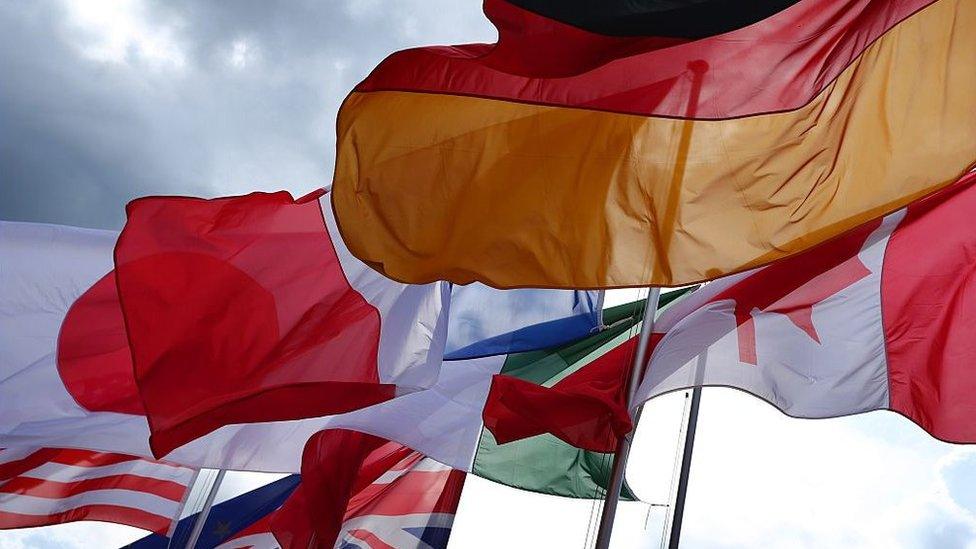Connecting Cornwall to the G7 countries
- Published
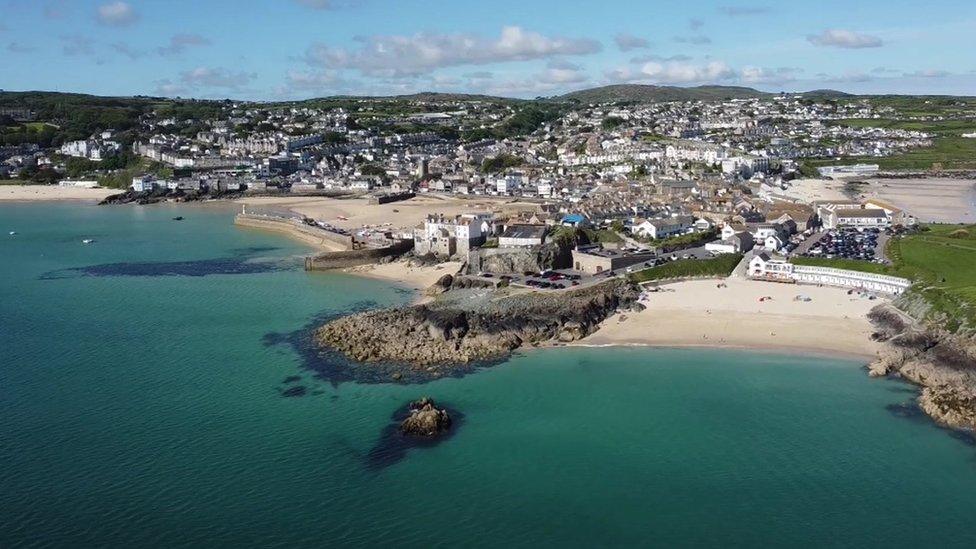
Cornwall's coastline will provide the backdrop to the G7 summit
This week Cornwall hosts the leaders of the world's largest so-called advanced economies at the G7 summit.
Cornwall has a rich heritage and, with millions of Cornish descendants spread around the world, there are enduring international connections.
It is a place that has had an important role in some key innovations, from the invention of steam power to the development of communications.
Here are some examples of how Cornwall is linked to the visiting countries.
Canada
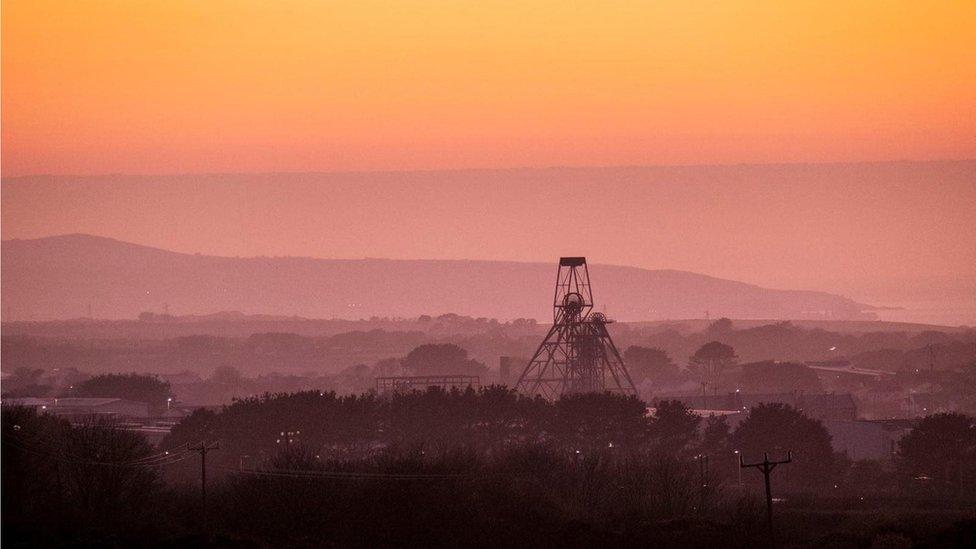
Canada received Cornish "Cousin Jacks" - or Cornishmen - many with mining expertise, and has modern connections with South Crofty mine
In the 18th and 19th Centuries, Cornwall was the global centre of tin and copper mining.
Up to 500,000 Cornish miners took their expertise and shared their skills abroad, in countries including Australia, USA, Canada, Peru, Mexico and South Africa.
These also included those looking to make a living after the price of copper crashed in 1866.
"There are an estimated six million living around [the world] today who are descended from those migrant Cornish workers," according to Cornish Mining World Heritage.
In Canada, communities were formed in Newfoundland, Ontario and the Prairie Provinces, and Cornish is included as an ethnicity option on the Canadian census, external.
'Tremendous future'
The last mine to stop working in Cornwall was South Crofty in 1998, but in 2017 Strongbox Exploration, a mining company with Canadian connections bought it with a plan to mine for tin once more.
The company has changed its name to Cornish Metals and is now listed on the London and Toronto stock exchanges.
Richard Williams, chief executive, who lives in Vancouver, said: "What we have seen over the last year in particular is much greater demand for electronics, and tin is a fundamental component in anything electronic.
"Cornwall has a wealth of tin so we think it has got a tremendous future."
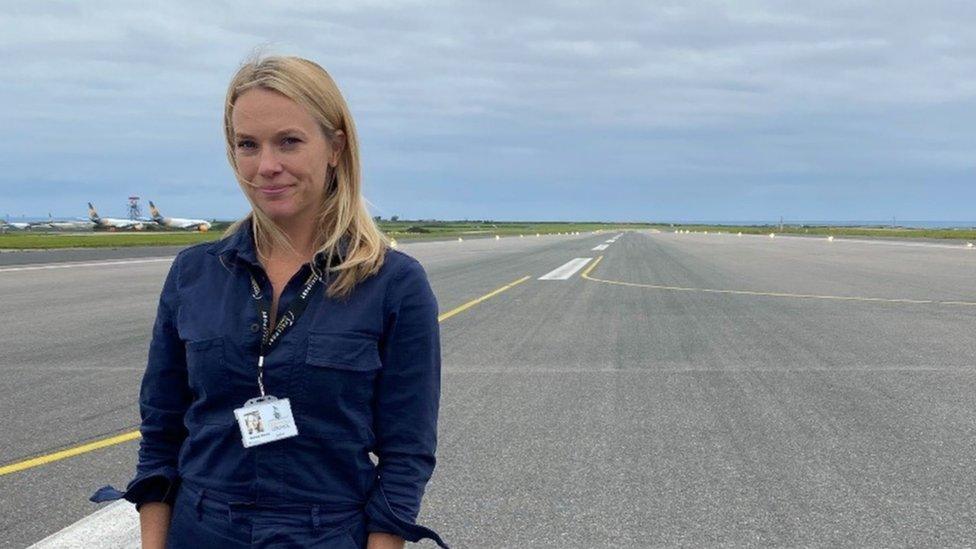
Melissa Thorpe thinks G7 is a great opportunity for Spaceport Cornwall
As well as having a stake in what lies underground, there is also Canadian interest in a Cornish project focussed on the sky.
Melissa Thorpe, from British Columbia, Canada, is head of Spaceport Cornwall, aiming to be the first UK venture to launch into space.
She said hosting the G7 in Cornwall was a "huge opportunity" for the spaceport: "We will use this platform to challenge outdated perceptions of Cornwall and showcase our innovative project with Virgin Orbit.
"We want to challenge other countries to look at their launch activities and consider ways that we can access space more responsibly and sustainably."
One further Canadian connection is the Davidstow Creamery, near Camelford, the largest cheese factory in the UK, which is owned by Canadian company Saputo.
France
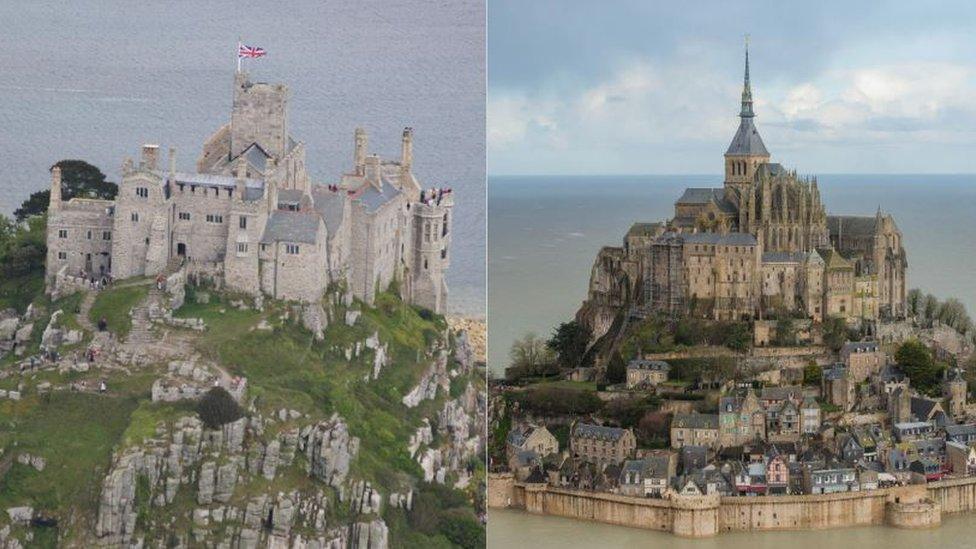
There are many similarities between Cornish and Breton cultures, and between St Michael's Mount (left) and Mont St Michel
The G7 summit website refers to Cornwall's "distinct cultural identity, including its own language and traditions, and is recognised as one of the six 'Celtic nations'".
These nations are Wales, Scotland, Ireland, the Isle of Man, along with Brittany in north-west France.
Cornwall is geographically closer to Brittany than London, the languages are similar, as is the coastline and the strong vein of independence.
Also binding the two areas is one of the most significant raids of World War Two.
In March 1942, Operation Chariot was launched from Falmouth, with the obsolete destroyer HMS Campbeltown packed with explosives heading for the strategically important German fortress at St Nazaire on the west coast of France.
HMS Campbeltown was remodelled to look like a German ship, allowing it to safely sail six miles (9.6km) up the Loire estuary, past 80 German emplacements, and was rammed into the dock gates.
The explosives detonated and 600 commandos disembarked from it, and 18 smaller accompanying vessels.
Many of the commandos were captured and 169 died in what has become known as "the greatest raid, external" that took the port out of service for the remainder of the conflict.
Falmouth will host the media for this summit, but it could also welcome a French visit to the memorial on the Prince of Wales pier, a short stroll from the International Media Centre.
Germany
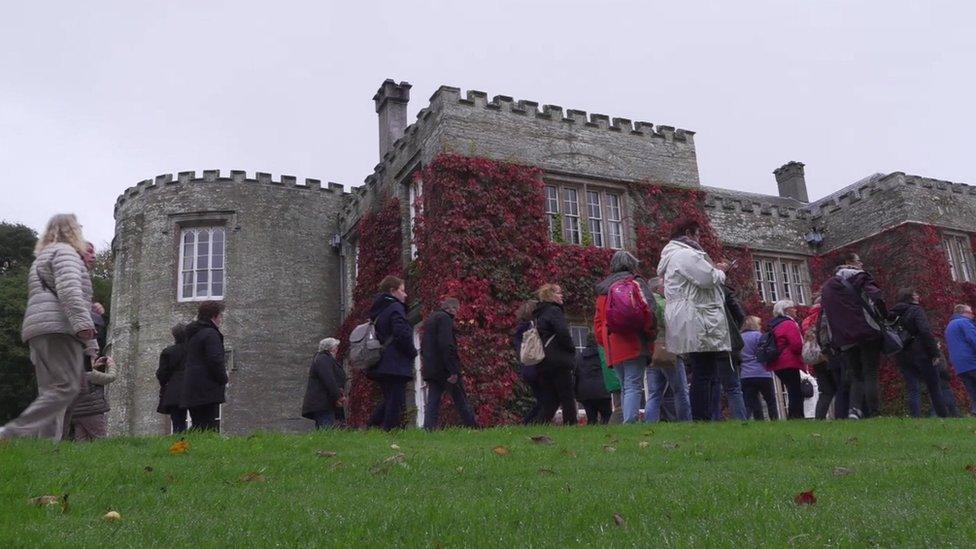
Prideaux Place near Padstow has been used in 14 German dramatisations of Rosamunde Pilcher stories
In 2019, there were about 350,000 foreign visitors to Cornwall, and Germany accounted for 96,000 of them, according to Visit Cornwall.
Cornwall's "stunning landscape" is referred to in the G7 literature, and it has inspired a number of well-known writers - Winston Graham, Daphne du Maurier and Virginia Woolf among them.
More recently, Rosamunde Pilcher, from Lelant, may have been popular as a novelist in the UK, but in Germany she is a household name.
Film crews are regularly seen recreating her stories for Sunday night TV slots on German network channel ZDF, watched by about eight million viewers.
There have been more than 100 episodes broadcast and one of Ms Pilcher's most celebrated stories, Shell Seekers, is largely set in a hotel in Carbis Bay.
Italy
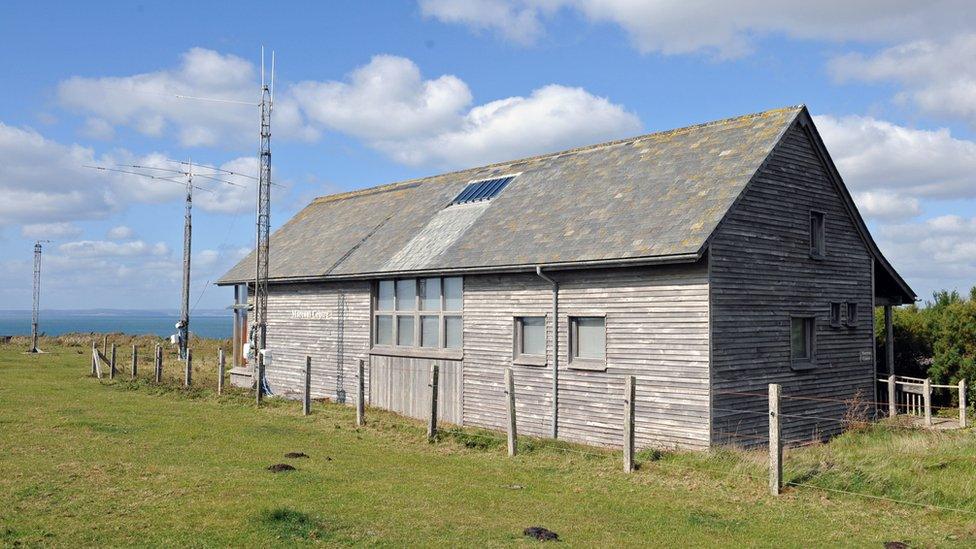
The Marconi centre at Poldhu is managed by the National Trust
Another industry that Cornwall has played a significant role in is communications, with GCHQ at Bude, and Goonhilly Earth Station on the Lizard continuing to do so.
In a 2017 BBC documentary, Invented in Cornwall, Professor Lucie Fisher said "Cornwall has been at the forefront of the communications revolution for 150 years."
In the late 19th and early 20th Centuries, west Cornwall was at the centre of a communications revolution.
'Momentous'
In Porthcurno, a cable was brought ashore that would allow the first messages to be sent to and from India in 1870.
Thirty years later, Italian engineer Guglielmo Marconi sent the first ever trans-Atlantic radio transmission from Poldhu, Cornwall.
Historian David Barlow said: "This was most definitely a pivotal moment in the history of communications. It is as famous now as it was 100 years ago. It was a momentous thing to do, it really was."
Such was its significance that, not long afterwards, Poldhu also received the first wireless message ever sent from the US, by President Theodore Roosevelt to King Edwards VII on 18 January 1903.
Japan
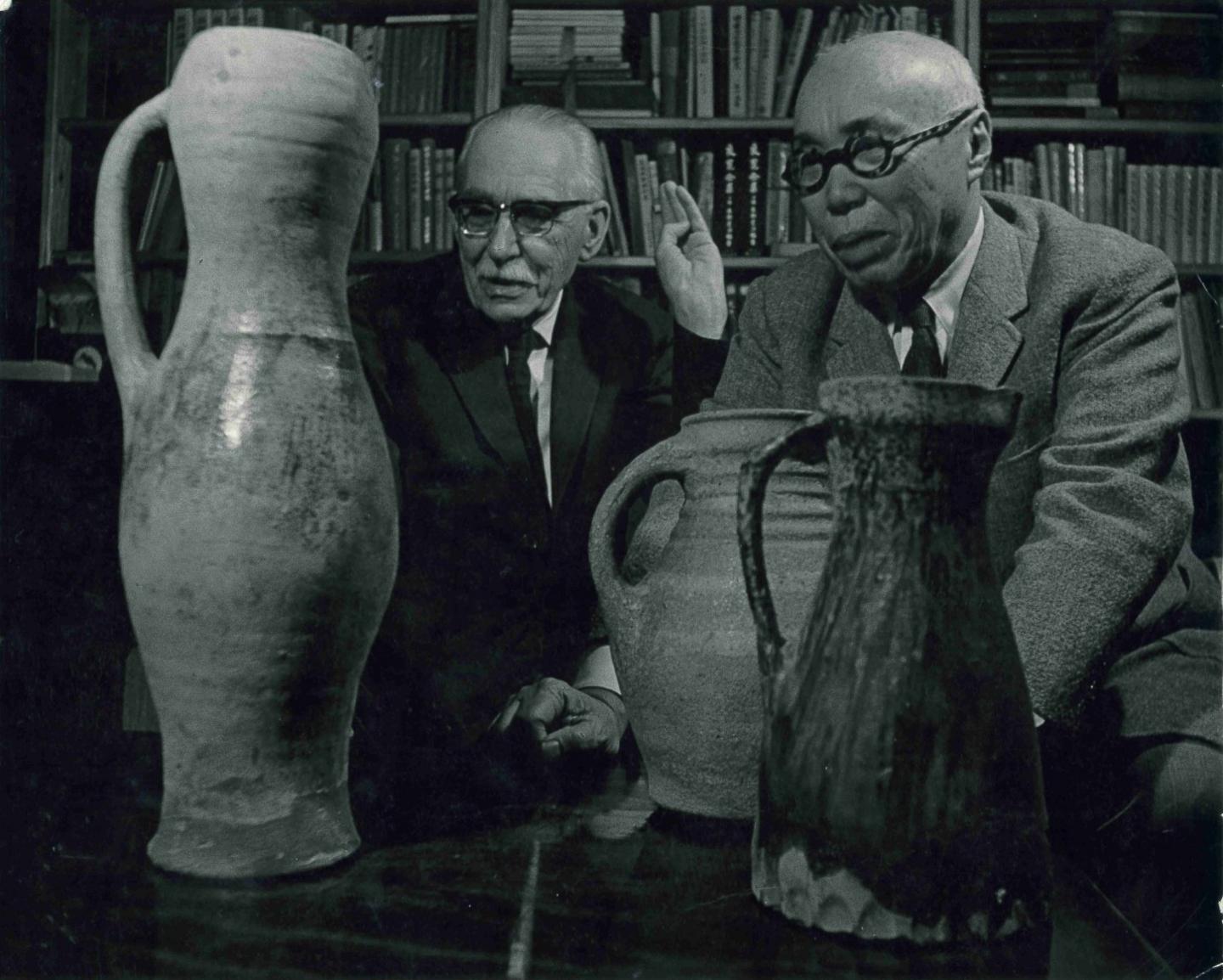
Bernard Leach and Shoji Hamada provided by the Crafts Study Centre University for the Creative Arts
Cornwall is a place that attracts artists with St Ives as a focal point.
Famed for its light and turquoise waters, 20th Century artists including Alfred Wallis and Ben Nicholson based themselves there, and it is home to a Tate gallery.
Sculptor Barbara Hepworth is perhaps the best known former artistic resident, along with potter Bernard Leach, and both have museums in the town.
Leach founded his St Ives pottery with Shoji Hamada, who he had travelled back from Japan with after meeting in 1920.
'Enduring friendship'
A century on, the relationship endures and their work continues to influence ceramics and studio potters around the world.
Mr Hamada returned to Japan and helped establish the town of Mashiko into a world-famous pottery centre and he was made a Living National Treasure by the Japanese government.
Dr Matthew Tyas, curator and deputy director at the Leach Pottery, called it "an enduring friendship", adding "St Ives' cultural relationship with Japan is expansive and growing.
"Likewise, the local communities of St Ives and Mashiko have grown closer over the years, with the relationship being formalised in a declaration of friendship and cultural collaboration in 2012."
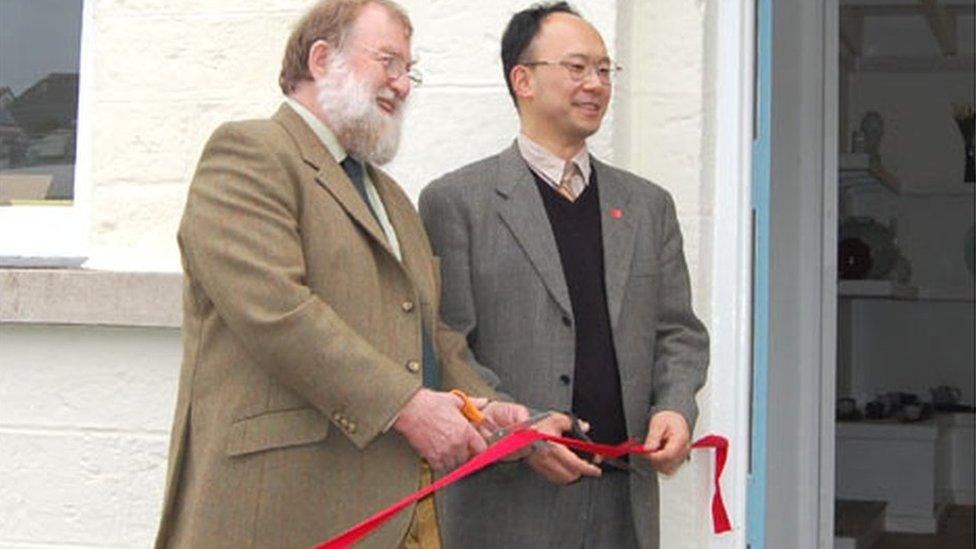
In 2014, the pottery restoration project was opened by John Leach, the eldest grandson of Bernard Leach, and Tomoo Hamada, grandson of Shoji Hamada.
There is also a rail connection between one of Cornwall's most famous sons, Richard Trevithick and Japan.
He pioneered the world's first high-powered steam powered engine and his grandson, also Richard Trevithick, is revered in Japan having built the first locomotive in the country.
United States of America

Rick Rescorla was head of security at Morgan Stanley and held regular evacuation drills for employees
The G7 literature states that about two million Americans trace their ancestry to Cornwall with communities that continue to have strong connections.
Grass Valley in California, Mineral Point in Wisconsin, Copper Country in Michigan, Butte in Montana and others all have shops selling pasties and celebrate St Piran's Day - the patron saint of tin miners, and one of three patron saints of Cornwall - on 5 March each year.
Close to Carbis Bay, at the side of the river in Hayle, lies a discreet plaque commemorating a Cornish hero.
Rick Rescorla was in charge of security for the bank Morgan Stanley during the World Trade Centre attacks in New York on 11 September 2001.

There is a memorial to Rick Rescorla in his home town of Hayle in Cornwall
Having anticipated an attack of this sort, he regularly drilled the staff in evacuation procedures.
On the day of the attack, he led more than 2,500 staff safely out of the south tower, singing Cornish songs as he did so, before returning inside to collect anyone left behind.
The building collapsed and he was among the 2,605 killed.
The US Department of Homeland Security formed a Rick Rescorla award for resilience, external to recognise superior leadership, and it would be a fitting tribute for the visiting president to pay his respects.
- Published7 June 2021
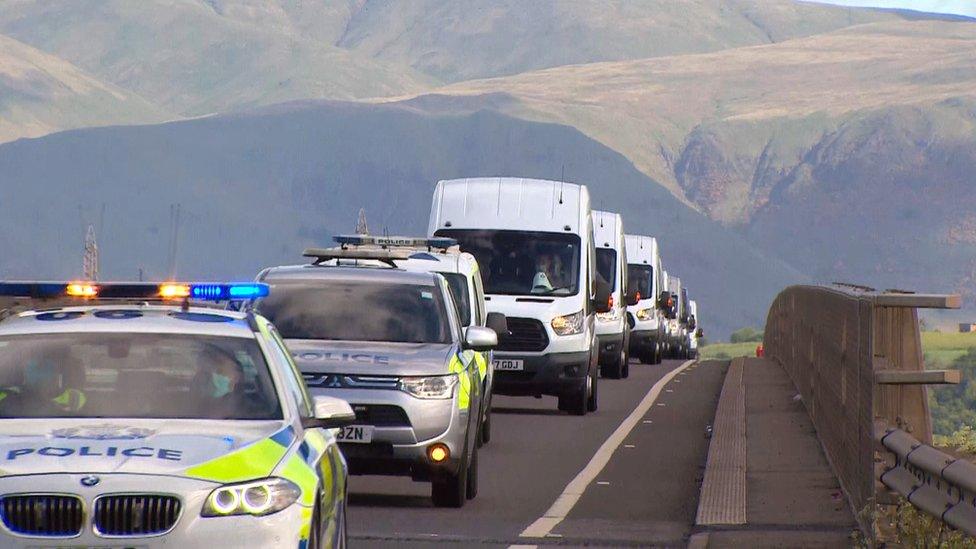
- Published8 June 2021
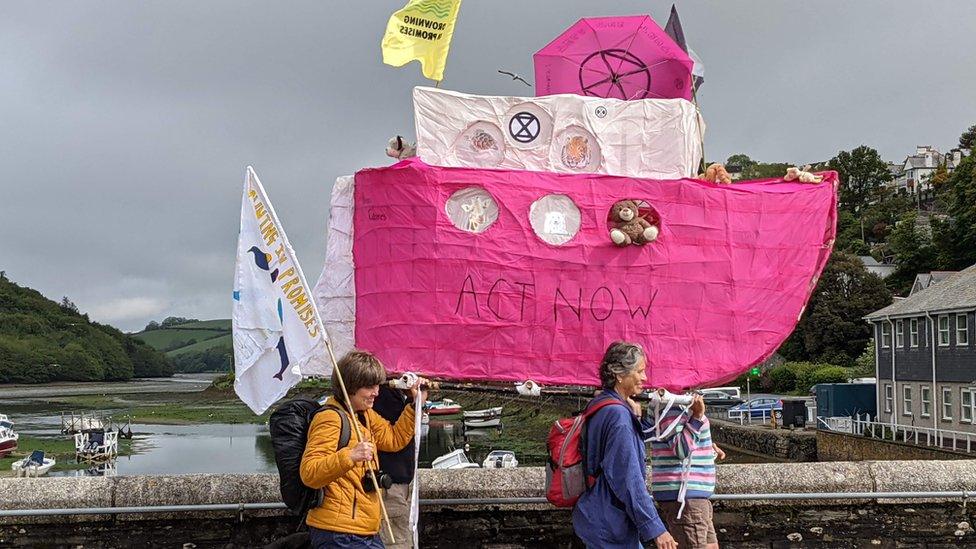
- Published13 June 2024
